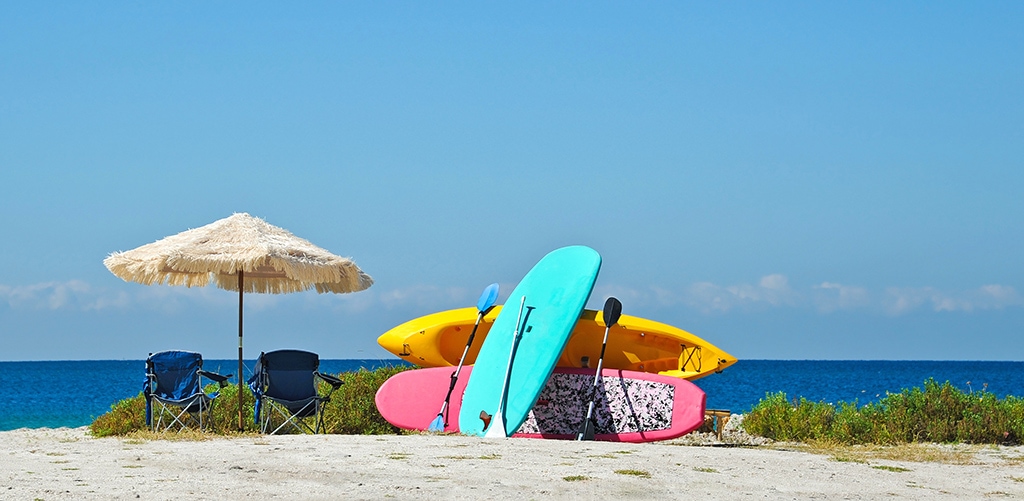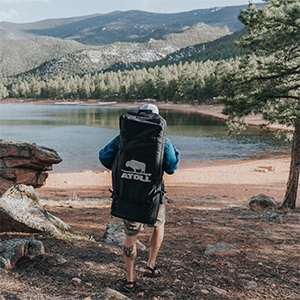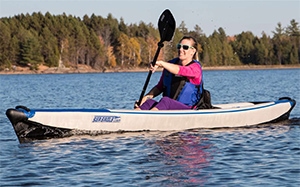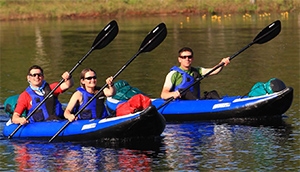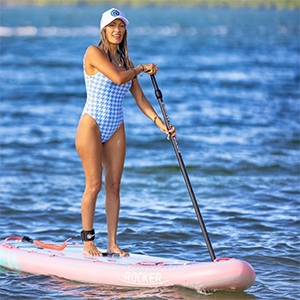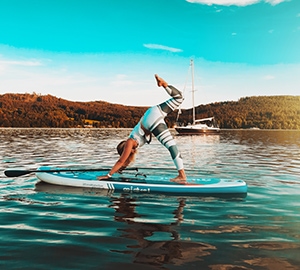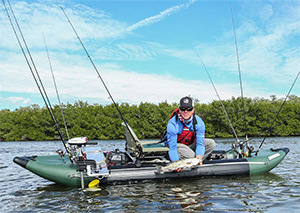Can’t decide between kayaking and paddle boarding? You’re not alone.
These two paddling water sports are perfect if you need to take a break from your busy schedule and get some nature therapy. While it would be amazing to have them both, it’s not an option for most people, hence the paddle board vs. kayak debate.
In this post, I’ll compare kayaking and SUPing to help you decide which one is best for you.
RELATED: Discover the best stand up paddle boards of 2024.
Key Takeaways
- Kayaks are generally more stable, faster, comfortable, and spacious than SUPs, but they are also heavier, bulkier, and harder to transport and store.
- SUPs are generally more versatile, fun, and easier to handle than kayaks, but they are also less suitable for cold weather, long distances, and dry storage.
- Both kayaking and SUP can be easy or challenging exercises depending on the paddling conditions and intensity. SUP burns more calories and engages more muscles than kayaking.
- Both kayaking and SUP can be used for fishing, but SUPs offer more visibility and mobility while kayaks offer more stability and storage.
Which Is Easier: Kayaking or Paddle Boarding?
Both stand up paddle boarding and kayaking can be easy and gentle exercises. Anyone can do them regardless of age or fitness level. It doesn’t take long to master the basic skills either.
Additionally, you can choose how easy or how challenging you want your exercise to be. Recreational paddling is great if you want something simple and relaxing, while whitewater paddling makes an awesome, intense activity. You can do both on a SUP or kayak.
Stand Up Paddle Boards vs Kayaks: Honest Comparison
You have to understand how the two kayaking and SUPing compare in different key areas to know which one is right for you.
Let’s take a closer look.
1. Storage and Portability
Kayaks are bigger and bulkier compared to stand up paddle boards.
If you decide to buy a kayak you will need more storage space. This means that it’s probably not a good option for people who live in small apartments. Even though you have the storage space, carrying it to and from the water or in and out of storage each time you use it is quite the task – since kayaks are heavy.
A stand up paddle board is smaller and has a more compact shape, making it easier to handle. You also don’t need a large storage space–even paddlers who live in small houses have options. If your SUP board is gorgeous, for instance, you can buy a storage rack and display it on a wall in your home.
SUP boards are also easier to transport than kayaks. One person can lift a paddle board onto the roof of a car without issues while it takes much more effort to lift a kayak to that level. Some kayaks weigh over 100 pounds!
The conversation changes when it comes to inflatable kayaks vs inflatable SUPs. They both deflate and fold into smaller packages.
Winner: stand up paddle board
2. Comfort
This one is more of a personal preference. Kayak paddling is done from a sitting position and SUP paddling from a standing position.
Sitting is more comfortable over long distances, especially if you have a kayak seat with great padding and back support. Sit-in kayaks can limit movement but as long as it’s the right size and you have enough legroom, you will be comfortable. Sit-on-top kayaks allow more room for movement and some are super stable so you can stand and stretch your legs.
Standing on a SUP for hours can be exhausting. You can kneel, sit, and even paddle in the prone position but it is still not as comfortable as a yak.
Winner: kayak
3. Cost of Getting Started
One of the things that kayaks and SUP boards have in common is the price range.
Some SUPs and kayaks cost as little as $200 while the high-end ones go for as much as $3000.
At the low end of the price range, you mainly get inflatable SUP boards and kayaks. These cheap SUPs and kayaks are great for beginners. The expensive ones have more features and most of them are designed for specific activities like fishing, racing, etc.
You can get a good cheap inflatable kayak or inflatable paddle board even with a really low budget. You’ll also have a lot of options if you decide to go all out and get a fancy model. Plus, most paddle boards and kayaks come with the basic accessories you need to get started.
So there’s no winner here.
Winner: none
4. Gear Storage
You have to bring gear and other essentials with you on your SUP or kayak trips and the length of the trip determines how much you’ll bring.
Day-long tours don’t require much gear and you will be fine with either a kayak or SUP board. Stand up paddle boards usually have bungee tie-downs at the front and rear which allow you to carry a bag or two and a cooler box.
For long-distance paddling and multi-day excursions, you will need to bring a lot of stuff. Most kayaks offer multiple on-board storage options for more gear. Sea kayaks, for instance, have dry hatches, bungee tie-downs, and more room inside the cockpit. You’d be surprised to see how much camping gear you can fit into a yak.
Another advantage of kayak storage is that you can keep some of your gear dry by storing them in the dry hatches. Stand up paddle boards don’t have dry hatches and water will splash all over your stuff–unless you use waterproof dry bags.
Winner: kayak
5. Paddling in Warm Weather
Sit-inside kayaks are built with a cockpit and, as you can tell from the name, you sit with your lower body inside the cockpit. It is not a big cockpit and movement is a little restricted. This is not a desirable situation in hot weather.
Imagine being stuck in a small cockpit in the summer heat and you can’t move as freely as you’d like. You consider jumping in for a quick refreshing swim but getting out of the cockpit and back in is just too much trouble. It doesn’t sound like a fun situation, does it?
Paddle boarding is different. Your whole body is exposed and you can enjoy the gentle and cooling ocean breeze in addition to having more freedom to move around. Besides, jumping off the SUP to take a swim is easy, and so is getting back on.
You can also just lay on your paddle board and soak up the sun as you float around.
Winner: stand up paddle board
6. Paddling in Cold Weather
In cold paddling conditions you want to stay dry, which can be impossible with a SUP board. Using a spray skirt with a sit-inside kayak will prevent water from getting into the cockpit and keep your lower body dry and warm.
You can’t say the same for a paddle board because the entire body is exposed and getting wet is pretty much expected.
Winner: kayak
7. Stability and Learning Curve
This is an important point for beginners. You don’t want to spend eternity trying to learn a new sport instead of having fun. Fortunately, these two sports are quite easy to learn and you can master the basic skills in a day.
Learning how to maintain balance on a stand up paddle board can be challenging at first. But once you get it, you can start learning proper paddling techniques and you will be good to go. Getting back on a SUP board when you fall off is also super simple.
Kayaking is quite easy as well but there are some techniques, like the Eskimo roll, that can take a while to master. Getting back onto your kayak when it capsizes can be hard too. It’s even harder with sit-in kayaks because they can take on water.
Both kayaks and paddle boards are stable–there are super wide and stable kayaks and SUPs for beginners. With all other factors remaining constant, however, a kayak will be more stable. Your center of gravity is lower when you are seated and this means more stability. You are less likely to end up in the water with a kayak.
But if you buy a good beginner SUP board, you won’t have anything to worry about.
Winner: stand up paddle board
8. Performance
The maneuverability of both kayaks and paddle boards depends on their size. Short and narrow paddling vessels are easier to handle and turn, which is why they are preferred for whitewater paddling.
When it comes to speed, kayaks win. First, you don’t have to switch paddling sides, thanks to the double-sided kayak paddle. A SUP paddle has only one blade and you need to keep switching sides to make it go straight. This can slow down your paddling movement.
Another thing, you sit in a kayak which means you face less resistance and can move faster on the water. SUP involves standing which means more resistance and reduced speed.
Winner: kayak
9. Fitness and Calorie Burn
Kayaking engages your upper body, and your leg muscles don’t do a lot of work since you paddle while seated. It is a great workout if you are looking for an effective back, core, arm, and shoulder workout.
Stand up paddle boarding, on the other hand, is a full-body workout–no muscle is left out, from your neck to your toes! Many people love it because it is so much fun and you never really realize how hard your muscles are working.
It is one of the best gentle exercises for building core strength. The core muscles work hard to keep you balanced and that is also where the power for your strokes comes from.
As far as calories go, SUP burns more calories than kayaking. According to Captain Calculator, a 100-pound person will burn 286 calories in an hour of SUP and 239 calories in an hour of kayaking. Heavier people burn more calories and you can increase the intensity with both sports.
Paddle boarding is a great exercise if you want to tone more muscles and burn more calories.
Winner: stand up paddle boarding
10. Fitness Activities on the Water
Doing yoga or pilates on a kayak sounds almost impossible, especially a sit-in kayak. Sit-on-top kayaks are super stable, in addition to having an open deck. You can do poses like the headstand or crow pose as well as a few other exercises that don’t require an even surface.
However, kayaks don’t have flat decks or deck pads, so doing the exercises can be hard, uncomfortable, and awkward.
Stand up paddle boards have a nice flat surface that makes fitness activities possible. All boards also come with a deck pad that is grippy and comfortable, it acts as your floating yoga mat. You can do many different types of exercises on the water including pilates and yoga routines.
Winner: stand up paddle board
11. Fishing
This paddleboard vs kayak debate wouldn’t be complete if we didn’t discuss fishing. It is a popular activity and both SUPs and kayaks offer amazing fishing platforms.
SUP fishing and kayak fishing provide a way for you to access tight spots that you can’t get to with a boat. However, the two activities have a few differences.
Fishing from a kayak is mainly done from a sitting position but there are fishing yaks that are stable enough for you to fish while standing. So you get the comfort of sitting down when you are tired and the advantage of standing when you need to get a better view.
Another great thing about kayaks is gear storage. Some anglers like to carry a lot of gear and a fishing kayak is more suited. You will have many storage options for your long kayak fishing trips.
The best thing about paddle board fishing is that you can see your surroundings better while standing. You can also move around as much as you like and even turn 360 degrees. But you may want to attach a kayak seat for when you want to rest your legs. (A SUP cooler can work as a seat too).
Fishing paddle boards come with gear mounts for rod holders as well as bungee cords for storage. You may not be able to carry a lot of stuff but you can definitely bring enough gear for an amazing angling experience.
Winner: kayak
12. Vessel Versatility
A stand up paddle board can do everything that a kayak can do and more. People use kayaks for fishing, touring, racing, whitewater paddling, and surfing. You can use a SUP board for all these activities and there are even specific boards designed for each activity.
But in addition to the above sports, a paddle board can be used for fitness, family fun, and it is better for touring.
There is no way to try fitness routines on a kayak, it would be an awkward experience. A SUP offers a nice platform for yoga poses and pilates so you can make your sessions more interesting.
While you can bring your little ones and your dog on a kayak, a board is more suited, especially on hot days. There is more freedom for them to move around so they won’t feel confined, making them uneasy. They can also jump into the water for quick swims whenever they like.
Kayaks are fantastic for touring and sightseeing, but you can miss a lot when seated. Standing on a SUP offers an awesome view of the beauty around you and marine life under the water.
Winner: stand up paddle board
Who Is a Kayak Best for?
A kayak would be ideal for you if you want an isolated workout that heavily engages your upper body. It strengthens the shoulders, back, arms, and core muscles.
Kayaks are also the better option for fishing and long-distance touring, especially if you like to carry a lot of gear. The multiple on-board storage options provide more space for you to bring everything that you may need. Yaks even have dry hatches with lids. Your stuff will stay dry (it’s still safer to have a dry bag) and it won’t end up in the water if you capsize.
If you expect to go on really long trips, a kayak may be a great option because of its speed. The kayak paddle is double-bladed and you can cover long distances in a shorter time.
Do you consider yourself an adrenaline junkie? A kayak may be exactly what you’re looking for. In addition to being faster, yaks are the best for whitewater paddling. You can still use SUPs for whitewater but for extreme conditions, you should get a kayak.
Lastly, a kayak is best for paddlers who will be paddling in cold weather. With a sit-in kayak and spray skirt, you can stay dry and warm.
Who Is a Paddle Board Best for?
Stand up paddle boarding would be great for warmer climates, so if you live in a warmer area then SUP could be for you! You won’t have to be confined in the same position in a small cockpit and you can easily jump in the water to cool off.
While kayaking works the upper body, paddle boarding works pretty much every muscle group in your body. It is the ultimate full-body workout and among the best for burning calories. One of the things that make it such a great exercise is that it is gentle and anyone can do it. It would be good for you if you’re looking for a fun but effective exercise.
Additionally, you can always make your paddling sessions more exciting by adding a few yoga poses and pilates.
SUP boarding would also be a good option if you want to enjoy the great outdoors with your furry friend or kids. They will enjoy the comfortable platform and playing in the water, more so on hot days.
Paddle boards are great for touring and fishing too as long as you don’t expect to carry too much stuff.
SUP-Kayak Hybrid: Best of Both Worlds?
SUP-kayak hybrids come in different designs. It could be a kayak with a SUP-style deck (a flat and open deck) or a paddle board with a kayak seat attached.
The main benefit of getting a SUP-kayak hybrid is that it saves you money. You enjoy both worlds without having to buy two vessels. Plus, you won’t have to create storage space for a SUP and kayak, only one.
Unfortunately, a SUP-yak hybrid is not the best of both worlds. You will get a taste of each side but you will miss out on the best features of a SUP and a kayak.
Paddle Board Vs Kayak FAQs
Here are the most common SUP vs kayak questions.
Which Is Better: A Paddle Board or a Kayak?
Both kayaks and paddle boards are both amazing and each one has its pros and cons. Kayaks are great for cold weather paddling because of the enclosed cockpit. Most of them also have multiple storage options for gear.
Stand up paddle boards are great for warmer weather. On top of that, SUP boarding is a full-body workout and even has a nice platform for other fitness routines like yoga.
Is a Kayak More Stable Than a Paddle Board?
A kayak is not necessarily more stable than a paddle board. Kayaks and paddle boards come in different shapes and sizes. Those designed for beginners, fishing, and SUP yoga are wide and super stable. So it depends on the size of the specific vessel.
Why Are Paddle Boards More Expensive Than Kayaks?
Both kayaks and paddle boards can be expensive. Their inflatable versions are more affordable, with many of them going for less than $500. There are kayaks and SUPs that cost $2500+.
Is It Easier to Kayak or Paddle Board?
Paddle boarding and kayaking can both be very easy. They can be gentle exercises that anyone can do, regardless of age and fitness level. Learning them is also easy and you can master the basic skills in a day. Maintaining balance and proper SUP techniques may take a bit of practice. This goes for some kayaking skills like self-rescue too.
Are kayaks faster than paddle boards?
When comparing the speed of kayaks and paddle boards, kayaks typically emerge as the faster option.
This advantage is attributed to several key factors including the kayak’s streamlined design, which offers less resistance in the water, and the efficiency of using a double-bladed paddle.
Additionally, the seated position of a kayaker lowers their center of gravity, enhancing stability and enabling more powerful strokes.
While paddle boards have their own set of advantages, such as a higher vantage point for sightseeing, kayaks generally provide a swifter mode of water transportation.
Kayaks Vs Paddle Boards: Conclusion
YOU MAY ALSO LIKE: Discover the Best Places to Paddleboard in Central Florida.
Kayaking and paddle boarding are fantastic activities and it can be hard to choose one over the other. Knowing how they compare in different key areas makes the decision easier.
Yaks are more comfortable when paddling long-distance and they are faster. You will have more on-board storage options with a kayak and it is the better option for cold-weather paddling.
SUPs are easier to store and transport. They are also more versatile and the best option for warm weather paddling. Paddle boarding is a better workout and burns more calories too.
So, which one is the best for you?
Happy paddling!

